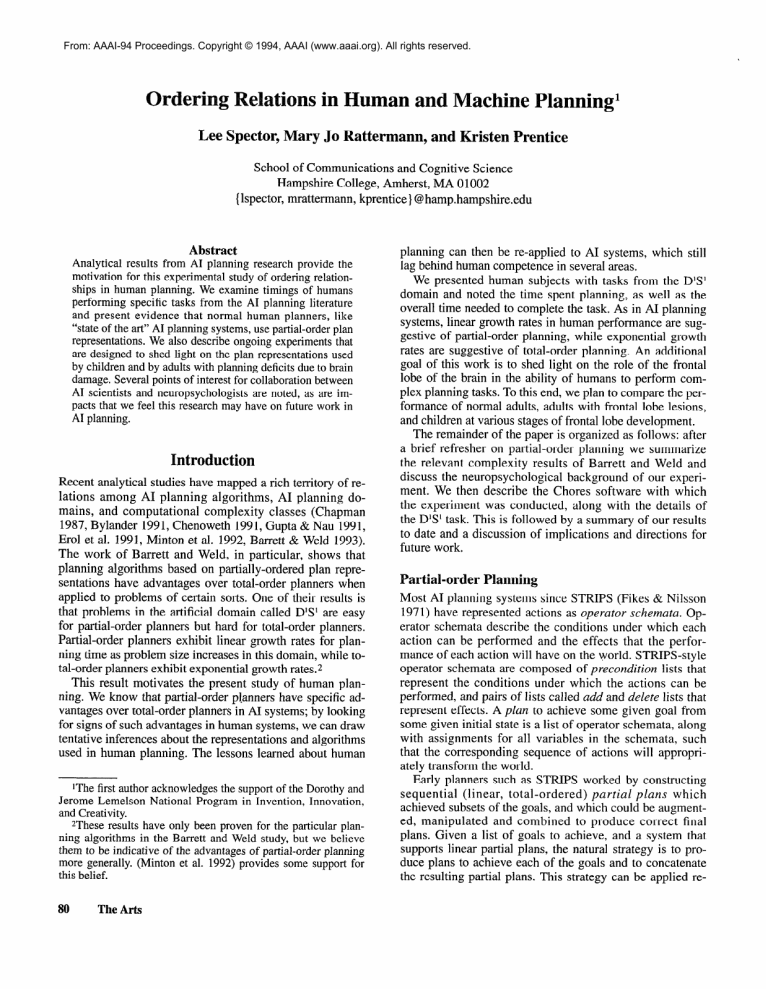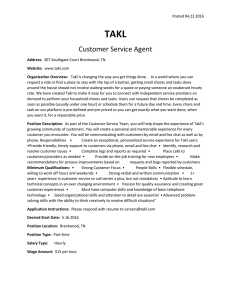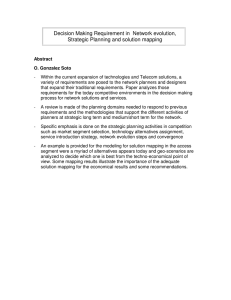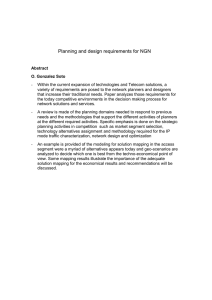
From: AAAI-94 Proceedings. Copyright © 1994, AAAI (www.aaai.org). All rights reserved.
Orderi
elations in Human and Machine Planning’
Lee Spector, Mary Jo Rattermann, and Kristen Prentice
School of Communications
and Cognitive Science
Hampshire College, Amherst, MA 01002
{lspector, mrattermann, kprentice} @ hamp.hampshire.edu
Abstract
Analytical results from AI planning research provide the
motivation for this experimental study of ordering relationships in human planning. We examine timings of humans
performing specific tasks from the AI planning literature
and present evidence that normal human planners, like
“state of the art” AI planning systems, use partial-order plan
representations. We also describe ongoing experiments that
are designed to shed light on the plan representations used
by children and by adults with planning deficits due to brain
damage. Several points of interest for collaboration between
AI scientists and neuropsychologists
are noted, as are impacts that we feel this research may have on future work in
AI planning.
Introduction
Recent analytical studies have mapped a rich territory of relations among AI planning algorithms, AI planning domains, and computational
complexity classes (Chapman
1987, Bylander 1991, Chenoweth 1991, Gupta & Nau 1991,
Erol et al. 1991, Minton et al. 1992, Barrett & Weld 1993).
The work of Barrett and Weld, in particular, shows that
planning algorithms based on partially-ordered plan representations have advantages over total-order planners when
applied to problems of certain sorts. One of their results is
that problems in the artificial domain called D’S’ are easy
for partial-order planners but hard for total-order planners.
Partial-order planners exhibit linear growth rates for planning time as problem size increases in this domain, while total-order planners exhibit exponential growth rates.2
This result motivates the present study of human planning. We know that partial-order planners have specific advantages over total-order planners in AI systems; by looking
for signs of such advantages in human systems, we can draw
tentative
inferences
about the representations
used in human planning.
and algorithms
The lessons learned about human
iThe first author acknowledges the support of the Dorothy and
Jerome Lemelson National Program in Invention, Innovation,
and Creativity.
2These results have only been proven for the particular planning algorithms in the Barrett and Weld study, but we believe
them to be indicative of the advantages of partial-order planning
more generally. (Minton et al. 1992) provides some support for
this belief.
80
The Arts
planning can then be re-applied to AI systems, which still
lag behind human competence in several areas.
We presented human subjects with tasks from the D’S’
domain and noted the time spent planning, as well as the
overall time needed to complete the task. As in AI planning
systems, linear growth rates in human performance are suggestive of partial-order planning, while exponential growth
rates are suggestive of total-order planning. An additional
goal of this work is to shed light on the role of the frontal
lobe of the brain in the ability of humans to perform complex planning tasks. To this end, we plan to compare the performance of normal adults, adults with frontal lobe lesions,
and children at various stages of frontal lobe development.
The remainder of the paper is organized as follows: after
a brief refresher on partial-order planning we summarize
the relevant complexity results of Barrett and Weld and
discuss the neuropsychological
background of our experiment. We then describe the Chores software with which
the experiment was conducted, along with the details of
the D’S’ task. This is followed by a summary of our results
to date and a discussion of implications and directions for
future work.
Partial-order
Planning
Most AI planning systems since STRIPS (Fikes & Nilsson
1971) have represented actions as operator schemata. Operator schemata describe the conditions under which each
action can be performed and the effects that the performance of each action will have on the world. STRIPS-style
operator schemata are composed of precondition lists that
represent the conditions under which the actions can be
performed, and pairs of lists called add and delete lists that
represent effects. A plan to achieve some given goal from
some given initial state is a list of operator schemata, along
with assignments for all variables in the schemata, such
that the corresponding
sequence of actions will appropriately transform the world.
Early planners such as STRIPS worked by constructing
sequential
(linear, total-ordered)
partial plans which
achieved subsets of the goals, and which could be augmented, manipulated
and combined to produce correct final
plans. Given a list of goals to achieve, and a system that
supports linear partial plans, the natural strategy is to produce plans to achieve each of the goals and to concatenate
the resulting partial plans. This strategy can be applied re-
Initial
Goal
Figure 1. The Sussman Anomaly
cursively to any subgoals introduced in trying to achieve
any of the goals. But using linear partial plans in this way
leads to a difficulty that can be illustrated with a blocks
world problem known as the Sussman Anomaly: Given
three blocks labeled A, B, and C, and an initial state in
which C is on A, and in which A and B are both on the
table, construct a plan for building a tower with A on B and
with B on C (Figure 1). The difficulty is that no linear combination of the obvious partial plans for achieving On(A, B)
and On(B, C) will yield a correct plan for achieving their
conjunction. If On(A, B) is achieved first (by putting C on
the table on then putting A on B) then the new {A, B} stack
would have to be immediately
dismantled
in order to
achieve On(B, C). (Only one block can be lifted at a time.)
On the other hand, if On(B, C) is achieved first (by putting
B on C) then once again the new stack would have to be
dismantled in order to achieve the other conjunct.
The literature contains several strategies for circumventing this problem (e.g., (Sussman 1990, Sacerdoti 1975,
Waldinger 1977)). One of the most popular strategies involves the representation of partial plans as partial-orders,
rather than as total-orders. This allows for the representation of partial
plans
in which
some
of the ordering
deci-
sions have been left temporarily unspecified. A partially
ordered partial plan for the Sussman Anomaly might state
that On(A, B) and On(B, C) are both to be achieved,
but
that the order in which their plans are to be executed has
yet to be determined.
Further computation
may indicate
that additional
ordering
constraints
must be imposed;
in
the case of the Sussman
the actions into which
Figure 2 illustrates a solution to the Sussman Anomaly using
partially ordered action sequences.3
Most “state of the art” planning systems now use partiallyordered partial plans (e.g., (Chapman 1987, Currie & Tate
1991, McAllester & Rosenblitt 1991)). Several recent studies have examined the trade-offs in total-order vs. partialthe goals are decomposed
order
ences
planning;
some
in performance
Anomaly
will have to be interleaved.
of these
profiles
studies
quantify
between
the differ-
total-order
and
3See (Sacerdoti 1975, Tate 1977) for further detail.
4The third planner in the Barrett and Weld study (TOPI, for
“Total-Order, Prior-Insertion”) differs from TOCL along a different dimension and hence is of no interest to the present study.
Barrett and Weld mention that source code for all three planners
is available-send
mail to bug-snlp@cs.washington.edu.
5The full definition: “A set of n subgoals is laboriously serializable if there exists at least one serializable ordering yet at least
l/n of the subgoal orders can not be solved sequentially without
possibly violating a previously solved subgoal.” (p. 19)
Figure 2. Solving the Sussman Anomaly
with partially ordered partial plans.
partial-order planners (Minton et al. 1992, Barrett & Weld
1993). With regard to human planning, we know of no prior literature on the ordering relations in partial plans. The
results from AI planning systems can, however, be used to
structure experiments that provide data on the ordering relations used by humans in constructing action plans.
arrett & Weld’s Results and Domain
Barrett and Weld examined the performance of three planning algorithms on problems of several classes. Two of
their planners are of interest here: POCK (for “PartialOrder, Causal-Links”)
and TOCL (for “Total-Order,
Causal-Links”). POCL and TOCL differ, to the extent that
this is possible, only in the representation of ordering relations within partial plans; POCL uses partial-order representations while TOCL uses total-order representations.
Both POCL and TOCL use standard STRIPS-style operator
schemata. POCL is a variant of the systematic nonlinear
planning algorithm used in the SNLP planning
system
(McAllester
& Rosenblitt
1991), and TOCL is a modification of POCL in which an added “linearization”
step
forces all plans to be totally ordered.4
POCL and TOCL were run on large sets of problems from
both “real” and artificial domains. The real domains included blocks world, transportation planning, and others, while
the artificial domains were constructed to highlight the effects of specific patterns of goal interactions. The runtimes
for each planner on problems in each domain were analyzed, and several interesting generalizations were noted.
In accounting for the observed data, Barrett and Weld
extended Korf’s taxonomy of subgoal collections
(Korf
1987) to include two new classes: trivial serializability and
laborious serializability.
A set of subgoals is said to be
trivially serializable “if each subgoal can be solved in any
order without ever violating past progress,” while a set of
subgoals is said to be laboriously serializable “if there exist
an inadequate percentage of orders in which the subgoals
may be solved without ever violating past progress”5 (pp.
3-4). Barrett and Weld also produced the following result:
Proposition II Assuming that a problem’s subgoals
can be achieved in constant time, the expected time to
solve a problem rises linearly with the number of subCognitive Modeling
81
goals if the problem is trivially serializable,
exponentially if the problem is laboriously
able or nonserializable. (p. 36)
but rises
serializ-
It is important to note that the classification of a problem
as trivially or laboriously serializable depends on the planning algorithm that is being used; different planning algorithms induce different subgoal structures, and hence it is
possible for a single problem to be trivially serializable in
the search space of one planner and laboriously serializable in the search space of another. The artificial domain
called D’S’ is the simplest of Barrett and Weld’s domains
that is trivially serializable for POCL but laboriously serializable for TOCL. In D’S each operator has exactly one
precondition, one item on its add list, and one item on its
delete list. The precondition lists and add lists are all mutually disjoint, and each operator deletes the precondition of
one of the other operators. The pattern for the construction
of an n-operator D’S’ domain is:
Operator:
Action: Ai, Preconditions:
{Ii}, Add: (Gi}, Delete: {Zi-1)
where i ranges from 1 to n and where the delete list for A 1
is empty. The maximal solvable problems in this domain
have initial conditions consisting of all of the li and goal
conditions consisting of all the Gi. Note that the pattern induces a linear order on the solution to each maximal problem-each
operator deletes the precondition to the operator that must immediately precede it in the solution plan.
The results of Barrett and Weld tell us that partial-order
planners are capable of finding the correct order in linear
time, while total-order planners will generally require exponential time.
Neuropsychology of Planning
Neuropsychologists
have long studied the role of the
frontal cortex in human behavior, and in particular, the effects of damage to this area of the brain. It has long been
known that patients with frontal lobe lesions will often behave inappropriately in social situations, experience radical
mood swings, and display deficits in processing temporal
relationships
and order. These deficits appear despite
seemingly normal abilities in language, perception, verbal
expression, memory and attention (Grafman 1989, 1994;
Robertson et al. 1991). In addition to the previously described deficits, it has also been proposed that these patients experience deficits in planning and problem solving
(Grafman 1989, Shallice 1988). Unfortunately, the majority of neuropsychological
models fail to explicate the precise role of the frontal cortex in cognitive processes (Grafman 1989), and also rely on evidence which is obtained
from tasks not directly related to planning and problem
solving. One of the goals of our experiment is to provide
direct evidence for the role of the frontal cortex in plan6The general idea for the Chores software was derived from
the chore planning experiments
described in (Hayes-Roth &
Hayes-Roth 1979).
82
The Arts
ning behavior, and specifically, to show that damage to the
frontal cortex will lead to deficits in the patient’s ability to
form and carry out complex plans.
D’S’in the Chores Experiment
We are performing experiments
built using the NINDV
NIH Chores experiment
software (Spector & Grafman
1994) to explore the ordering representations
used in human problem solving. The software was designed for human planning experiments
with normal subjects, with
frontal lobe lesion patients, and with children at various
stages of frontal lobe development.6 The subject interacts
with a Macintosh computer that displays a map of a hypothetical city, with icons representing items that the subject
is to acquire (the goal list), and icons representing items
that the subject already possesses (the inventory). The subject uses the mouse and/or arrow keys to navigate around
the map and to perform chores. The subject can backtrack
by clicking an “Undo Previous” button-this
reverses the
effects of the most recently performed chore and moves
the subject to the location adjacent to that chore. A timestamped protocol that lists all of the subject’s actions is
produced; it can be analyzed to produce several data sets.
The Chores software can be configured to require that
constraints be obeyed on the ordering of the chore completions. In our experiments
we are using “resource” constraints that are specified in a manner almost identical to
STRIPS operator specifications.
On a separate screen
called “Item Info” each chore is listed along with its relations to resources. The subject may switch between the
map and Item Info screens at any time; the times of all
such actions are recorded in the protocol. The Item Info
screen may indicate that a particular chore “requires” one
or more resourcesthis means that the chore cannot be
completed if the resources are not currently in the inventory. The system produces a beep-sound and a time-stamped
annotation in the protocol whenever a subject attempts to
complete a chore without the necessary requirements.
A
chore may also “add” one or more resources-this
means
that successful
completion
of the chore will add the
specified resources to the inventory. If the added item was
a goal then it is also removed from the goal list. A chore
may also “delete” one or more resources-this
means that
successful completion of the chore will delete the specified
resources from the subject’s inventory. Note that the require, add, and delete specifications for chores are strictly
analogous to the precondition,
add, and delete lists for
STRIPS operators. This means that the human subjects
will be performing tasks quite similar to those performed
by AI planners that manipulate STRIPS operators.
In the present experiment we are interested in the relation between planing time and task size (number of goals).
We are using the time spent viewing the Item Info screen
as our principal indicator of planning time. The total time
to trial completion is also of interest, but this will include
time spent manipulating the user interface that may be unrelated to planning time.
The D’S’ Series is a set of trials built using the Chores experiment software. The entire task consists of two training
trials, four test trials, and four foil trials, which are randomly
presented to the subject. The first of the two training trials
introduces the subject to the basic structure and rules of the
task, including the “requires” and “adds” functions, while
the second training trial introduces the “deletes” and “undo
previous” functions. The four D’S’ trials are as follows: a 2goal problem in a 2-operator D’S’ domain, a 3-goal problem
in a 3-operator D’S’ domain, a 4-goal problem in a 4-operaand a 5-goal
problem
in a 5tor D’S’ domain,
operator D’S’ domain. The foils are similar to the D’S’ trials,
but they do not actually conform to the D’S’ pattern. To minimize the effects of varying spatial reasoning abilities, all of
the maps have the same simple linear layout.
Subjects and Methods
Seventeen normal adults and two frontal subjects were tested in this experiment. Normal subjects were screened for
histories of motor and cognitive impairment, and any necessary corrective lenses were worn during testing. Frontal
subjects were diagnosed to have cortical damage located in
the frontal lobe.
Testing took place in a testing room with only the subject and experimenter present. The subject was seated in
front of the computer monitor and was introduced to the
experiment with the training trials. The following instructions are a summary of those given to the subjects:
The goal of this experiment is to obtain a set of items by
going to the places on this map. Each time an item is obtained it is removed from the list of objects to get and
added to the inventory.
The places and items on the list are not thematically
linked. Thus, going to the “library” will not result in a
book being added to the inventory, rather, a triangle will
be added.
The small black square which designates position can
move forward or backward one square at a time, and a
particular place on the map is entered by moving the
black square on top of it. [Subjects are shown how to manipulate the square with the mouse and the arrow keys.]
The “Item Info” screen displays the relationships
between the places on the map and the items. If a place
“requires” an item, entry is prohibited unless that item is
in the inventory. If a place “adds” an item, then that item
will be added to the inventory when that place is entered. If a place “deletes” an item, then if that item is
present in the inventory it will be deleted. If the item is
not in the inventory then the deletion has no effect.
The “undo previous” button can be used to undo a previous move. This button may be pressed as many times as
necessary to undo to the desired move.
Subjects were encouraged to practice with the training
trials and to ask questions until they were comfortable with
the rules of the task. The subjects were informed that the
trials would be timed and that they should move through
them as quickly as possible, but that randomly guessing
the order in which to complete the chores would not be
beneficial.
The four D’S trials and four foils were presented in a
different random order to each subject. Upon the completion of each trial the subject protocol was saved for later
examination.
esults
We analyzed two aspects of the subjects’ performance in
the Chores task: Total time to completion and time spent
viewing the Item Info screen. The former is the amount of
time spent both planning and executing the plan; the latter
is a better measure of pure planning time, but it does not
include time spent planning from memorized item information. We had predicted that both measures would reveal
the hypothesized linear trend for the normal subjects, and
as can be seen in Table 1 and in Figures 4 and 5, this prediction was confirmed by the normals’ performance
on
both measures. A linear trend analysis performed on the
data from the normal subjects reveals a significant linear
trend for total time to completion
(F (1,48) = 31.14,
pc.0001) and a significant linear trend for time spent viewing the Item Information
screen (F (1,48) = 48.88,
g<.OOOl). Further support for our hypothesis is provided
by analyses of variance performed on both sets of data
which revealed a main effect of the number of Chores (F
(3,48) = 10.48, g < .OOOl for time to completion, and F (3,
48) = 16.74, p < .OOOl, for time spent viewing the Item Information screen).
Due to the small number of frontal subjects, statistical
analyses were not possible; however, as can be seen in Figures 4 and 5, their preliminary data is consistent with the
predicted exponential function.
iscussion
Based on suggestions that planning algorithms using partially-ordered
plan representations
have clear advantages
over total-order planners in particular AI planning domains, we set out to investigate the performance of human
planning systems in the same domains. Our results suggest
that our human subjects enjoy the same advantages. Using
the Chores software to test subjects in D’S’ domains, we
found that the subjects’ total time to completion and time
spent viewing the Item Information screen exhibited linear
growth rates as the problem size increased.
The data suggests that human planners represent the or-
Number of Chores
Two Chores
Three Chores
Four Chores
Five Chores
Time to
Completion
54.9 1
131.76
225.12
343.53
Viewing Item
Information
12.35
48.71
93.12
159.76
Table 1. Mean total time and mean time spent viewing Item Info.
Cognitive Modeling
83
g 1000 -
-D Normals
* Frontals
P
#
800
u”
3
600
il
‘F
3
400
t2
200
0
I
Two
I
I
Three
I
I
Four
I
I
Five
Number of Chores
Figure 4. Mean Total Time to Completion, in seconds
dering relations in partial plans using partial-orders. The
data only shows that human planning time seems to increase linearly with increase in task size in the D’S’ domain. The inference that this implies the use of partial-order
representations relies on the assumption that the results of
Barrett and Weld are generally indicative of the advantages
of partial-order planning as opposed to total-order planning.
Although we believe this to be the case, we note that the
experiments provide data even if the results of Barrett and
Weld fail to generalize. The human planners are managing
to achieve linear performance
somehow. They are either
using partial-order
representations
or other algorithmic
methods that achieve the same effect with respect to
efficiency in this domain. One alternative is that the linear
human performance owes to the brain’s use of parallel algorithms.7 While such alternatives deserve further study,
we currently believe that partial-order representations provide the best explanation for the data.
An additional goal of this experiment was to examine
the role of frontal cortex in planning by testing patients
with frontal cortex lesions. Although preliminary, our results suggest that the performance of frontal patients in this
domain is more similar to that of total-order planners;
specifically, their performance seemed to exhibit an exponential growth rate as problem size increased. More data
from frontal patients is necessary to strengthen this claim.
Our results have implications
for both the psychology
and the neuropsychology
of planning, as well as for the AI
community. First, we have provided evidence that in a domain in which partial-order planning is advantageous, normal adults perform in a way that suggests the representation of partial-plan
ordering relations as partial-orders.
Second, we have preliminary evidence that suggests that
the frontal cortex of the brain may play a role in this type
of planning. While frontal lesion patients’ difficulty with
social situations and with temporal ordering is well docu-
mented, the effect of this damage on planning is not as
well studied. In our work, we have directly tested the ability of these individuals to form and carry out plans, and we
believe that their deficits lead to a specific pattern of performance with analogs in the computational literature.
The utility of partial-order planning, discovered by AI
planning researchers, receives further support from the evidence that normal humans appear to use partial-order plan
representations. Further study may uncover additional features of the algorithmic basis of human planning, both in
normal subjects and in subjects with planning deficits.
These studies may provide further support for current AI
techniques, but they may also provide alternative models.
Given that human planners are proficient in ways that current AI models are not, the interplay between the human
and machine studies should be of interest to those extending the state of the art in AI planning. The fruitfulness of
this interplay relies, however, on the coherence of the
cross-disciplinary
dialogue. We suggest that one way to
maximize the impact of psychological experimentation
on
AI practice is to construct the experiments within the conceptual frameworks developed in AI research.
Future Work
In our ongoing studies we are continuing our examination
of the role of frontal cortex in human planning. We are currently testing more frontally lesioned patients, and we have
adapted the procedure to make it appropriate for testing
7-ll-year-old
children. Based on research suggesting that
the frontal cortex does not fully develop until late in childhood, we expect to find that the younger children display
the same exponential performance that our frontal subjects
exhibit. This work will provide further evidence for the role
of the frontal cortex in human planning behavior.
Although the present study focuses on the representation
of ordering relations in partial plans, the same framework
can be applied to study other aspects of planning, and other
aspects of cognition more generally, across the human/machine frontier. AI research often yields precise, quantitative
800
Two
Three
Four
Five
Number of Chores
7We thank an anonymous reviewer for drawing our attention
to this possibility.
84
The Arts
Figure 5. Mean Time Viewing Item Information,
in seconds.
results that relate computational
structures to aspects of
performance.
By using these results as guides, we can
gather data on human cognition that will allow us to make
inferences about human computational
structures. And of
course there is always the possibility that we will be surprised; that we will find that the human computational
structures were other than we had expected. Since the concepts that underlie these investigations will be taken from
the computational literature, there should be clear paths by
which one could apply the lessons of the surprises in improving the state-of-the-art in AI.
Conclusions
In conclusion, we have found that the results of analytical
work in AI planning can be used to investigate
human
planning. Specifically, we have evidence that suggests that
normal human planners use partial-order representations
for partial plans, as do most modern AI planning systems.
We have further preliminary
evidence that suggests that
damaged human planning systems use methods akin to
those used in less efficient AI systems; specifically, we believe that adults with frontal lobe lesions will be shown to
be using planning methods similar to those employed in total-order planners. We believe that the parallels between
the human and machine cases are instructive, and that they
may lead to further developments in both human and machine studies.
Acknowledgments
Jordan Grafman funded and guided the development of the
Chores software, and, along with Jim Hendler, was instrumental in launching the larger interdisciplinary
effort of
which this work is a part. Paula Koseff ran several trials of
the experiment on subjects at NIH under Grafman’s supervision. Chris Chase and Neil Stillings helped in analyzing
the results. Jason Juneau worked on the software and is
part of the ongoing’experimental
team.
Erol, K.; Nau, D.S.; and Subrahmanian,
V.S. 1991. Complexity, Decidability
and Undecidability
Results for Domain-Independent
Planning. CS-TR-2797, Dept. of Computer Science, U. of Maryland.
Fikes, R.E.; and Nilsson, N. 1971. STRIPS: A New Approach to the Application of Theorem Proving to Problem
Solving. In Artificial Intelligence 2, 189-208.
Grafman, J. 1989. Plans, Actions, and Mental Sets: Managerial Knowledge Units in the Frontal Lobes. In Integrating Theory and Practice in Clinical Neuropsychology,
93138. New Jersey: Lawrence Erlbaum Publishers.
Grafman, J. 1994. Alternative Frameworks for the Conceptualization of Prefrontal Lobe Functions. In Handbook of
Neuropsychology, Vol. 9. Boller, F.; and Grafman, J. , eds.
Elsevier Science Publishers.
Gupta, N.; and Nau, D.S. 1991. Complexity Results for
Blocks-World Planning. In Proceedings of the Twelfth International Joint Conference on Artificial Intelligence, IJCAI-91,629-633.
Hayes-Roth, B.; Hayes-Roth, F. 1979. A Cognitive
Planning. Cognitive Science 3: 275-3 10.
Korf, R.E. 1987. Planning as Search: A Quantitative
proach. Artificial Intelligence 33: 65-88.
Model
Ap-
McAllester, D.; and Rosenblitt, D. 1991. Systematic Nonlinear Planning. In Proceedings of the Ninth National Conference on ArtiJicial Intelligence, AAAI-91, 634-639.
Minton, S.; Drummond, M.; Bresina, J.L.; and Philips, A.J.
1992. Total Order vs. Partial Order Planning: Factors Influencing Performance. In KR ‘92. Principles of Knowledge Representation and Reasoning - Proceedings of the
Third International Conference, 83-92. San Mateo, CA:
Morgan Kaufmann Publishers.
Robertson, L.C.; Lamb, M.; and Knight, T. 1991. Normal
Global-Local
Analysis
in Patients
with Dorsolateral
Frontal Lobe Lesions. Neuropsychologia 29,959-967.
Sacerdoti, E.D. 1975. The Nonlinear Nature of Plans. In
Advance Papers of the Fourth International Joint Conference on Artificial Intelligence, IJCAI- 7.5, 206-2 14.
References
Shallice, T. 1988. From Neuropsychology to Mental Structure, New York: Cambridge University Press.
Barrett, A.; and Weld, D.S. 1993. Partial-Order Planning:
Evaluating
Possible Efficiency Gains. Technical Report
92-05-01 Expanded Version, Dept. of Computer Science
and Engineering, U. of Washington, Seattle.
Spector, L.; and Grafman, J. 1994. Planning, Neuropsychology, and Artificial Intelligence: Cross-Fertilization.
In
Handbook of Neuropsychology,
Vol. 9, Boller, F.; and
Grafman, J., eds. 377-392. Amsterdam: Elsevier Science
Publishers.
Bylander, T. 1991. Complexity Results for Planning. In
Proceedings of the Twelfth International Joint Conference
on ArtiJicial Intelligence, IJCAI-9 I, 274-279.
Chapman,
D. 1987. Planning
for Conjunctive
Artificial Intelligence 32: 333-377.
Chenoweth,
S.V. 1991. On the NP-Hardness
World. In Proceedings of the Ninth National
on ArtiJicial Intelligence, AAAI-91, 623-628.
Goals.
of Blocks
Conference
Currie, K.; and Tate, A. 1991. O-plan: the open planning
architecture. ArtiJicial Intelligence 52: 49-86.
Sussman, G.J. 1990. The Virtuous Nature of Bugs. In
Readings in Planning. Allen, J.; Hendler, J.; and Tate, A.,
eds. 11 l-l 17. San Mateo, CA: Morgan Kaufmann Publishers, Inc.
Tate, A. 1977. Generating Project Networks. In Proceedings of the International Joint Conference on ArtiJicial Intelligence, IJCAI-77, 888-893.
Waldinger, R. 1977. Achieving Several Goals Simultaneously. Machine Intelligence 8 (1977).
Cognitive Modeling
85






